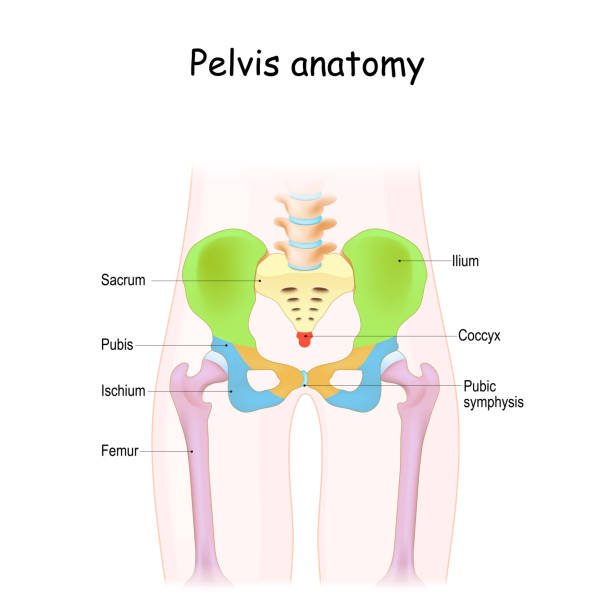Lightning Crotch During Pregnancy: Understanding and Managing Symphysis Pubis Dysfunction
Experiencing lightning crotch during pregnancy can be a shockingly intense and challenging experience.
However, with proper guidance and management, you can significantly improve the symptoms and discomfort associated with this condition known as symphysis pubis dysfunction (SPD).
In this article, we will delve into what SPD is and explore the various ways pelvic floor physical therapy can help alleviate its symptoms.
What is Symphysis Pubis Dysfunction
Symphysis Pubis Dysfunction (SPD), also referred to as pubic symphysis dysfunction, is a condition that commonly affects women during pregnancy, and occasionally men or women who have had pelvic surgery.
The pubic symphysis is a joint that connects the two halves of the pelvis at the front, and under normal circumstances, it allows for minimal movement between the pelvic bones.
However, during pregnancy, hormonal changes, such as increased relaxin levels, can cause the ligaments supporting the joint to become more relaxed and stretchy, leading to painful shearing at the joint and resulting in SPD.
Symptoms of SPD
The symptoms of SPD include pain in the pubic bone area, lower back pain, and discomfort that is often aggravated by activities such as walking, putting on pants, turning in bed, and climbing stairs.
Tenderness to touch at the pubic bone is also commonly experienced.
The severity of symptoms can range from mild discomfort to severe pain, significantly impacting daily activities.
Seeking early intervention is crucial to improving outcomes and reducing the risk of long-term pain.
How Can Pelvic Floor Physical Therapy Help?
Pelvic floor physical therapy is specialized in treating conditions like pubic symphysis dysfunction and can provide effective relief.
Here are some ways in which pelvic floor physical therapy can assist:
1. Posture Retraining: Pelvic floor therapists can help you improve your posture to minimize strain on the pubic symphysis and promote better alignment and stability.
2. Activity Modification: By avoiding asymmetrical activities, such as shifting weight into one hip or standing on one leg, and adopting specific techniques like pretending to wear a pencil skirt when getting in/out of a car or bathtub, you can reduce stress on the pubic joint.
3. Stabilization and Core Strengthening: Pelvic floor therapists will guide you in performing exercises that target the transverse abdominal muscles and promote overall core strength. These exercises can provide stability and support to the pelvis and lower back.
4. Abdominal Myofascial Release: Gentle stretching techniques can be employed to release tension in the superficial tissues of the abdomen, alleviating the pulling sensation on the pubic bone. This can also create space for the growing baby during pregnancy.
5. Adductor Soft Tissue Massage: Pelvic floor therapists can teach you how to perform a massage using a massage gun or hand roller to reduce tension in the inner thigh muscles. This helps decrease the strain on the pubic symphysis.
6. Pelvic Floor Muscle Relaxation and Trigger Point Release: Through manual therapy techniques, your therapist can help relax the pelvic floor muscles and release any trigger points that may contribute to pain and discomfort.
7. Education and Techniques for Pain Relief: Your therapist will review proper mechanics of lifting, teach muscle energy techniques for pain relief during transitions, and suggest alternate positions during childbirth to prevent aggravating pubic bone pain.
It's important to note that additional interventions such as supportive devices like SI belts for stability, rest and ice for inflammation reduction, and chiropractic or osteopathic treatment for realigning the pelvis can also complement pelvic floor physical therapy in managing SPD.
You’re not alone.
Symphysis pubis dysfunction during pregnancy can be a significant source of discomfort and pain.
However, with the guidance of pelvic floor physical therapy, you can find relief and improve your overall pregnancy experience.
By addressing posture, modifying activities, stabilizing the core, releasing tension in the abdomen and inner thigh muscles, and promoting relaxation of the pelvic floor, pelvic floor physical therapists can help you manage and reduce the symptoms of lightning crotch.
Every individual's experience with SPD may vary, and it's important to consult with a pelvic floor physical therapist who can tailor a treatment plan specifically to your needs. You can book a free 15-minute phone consultation to speak with one of our expert pelvic floor therapists here at Empower.
They will consider your unique circumstances and provide personalized guidance and exercises to alleviate your symptoms effectively.
By taking proactive steps and incorporating these techniques into your daily routine, you can minimize discomfort, enhance your pregnancy journey, and make everyday childcare activities more manageable.
It's essential to prioritize your well-being during this transformative time.
Don't hesitate to seek the support of a pelvic floor physical therapist who can empower you with the knowledge and tools to navigate and overcome lightning crotch, allowing you to embrace the joy of pregnancy and the early stages of parenthood.
Remember, you don't have to endure lightning crotch alone.
Reach out to a pelvic floor physical therapist and take the first step towards a more comfortable and enjoyable pregnancy experience.



